Tesco Business Functions, Accounting, and HR Analysis Report
VerifiedAdded on 2022/12/29
|20
|6579
|470
Report
AI Summary
This report provides an analysis of various business functions within the context of Tesco, covering key areas such as accounting, human resources, and customer service. It begins by defining business functions and their importance, followed by an examination of accounting's role in business success, including the use of profit and loss accounts. The report then delves into the different functions of the HR department, employment legislation, team development stages, motivation theories, and leadership styles. Furthermore, it explores the impact of customer service on business success and the benefits of customer profiling. The report uses Tesco as a case study, providing practical insights into how these functions operate within a real-world business environment.
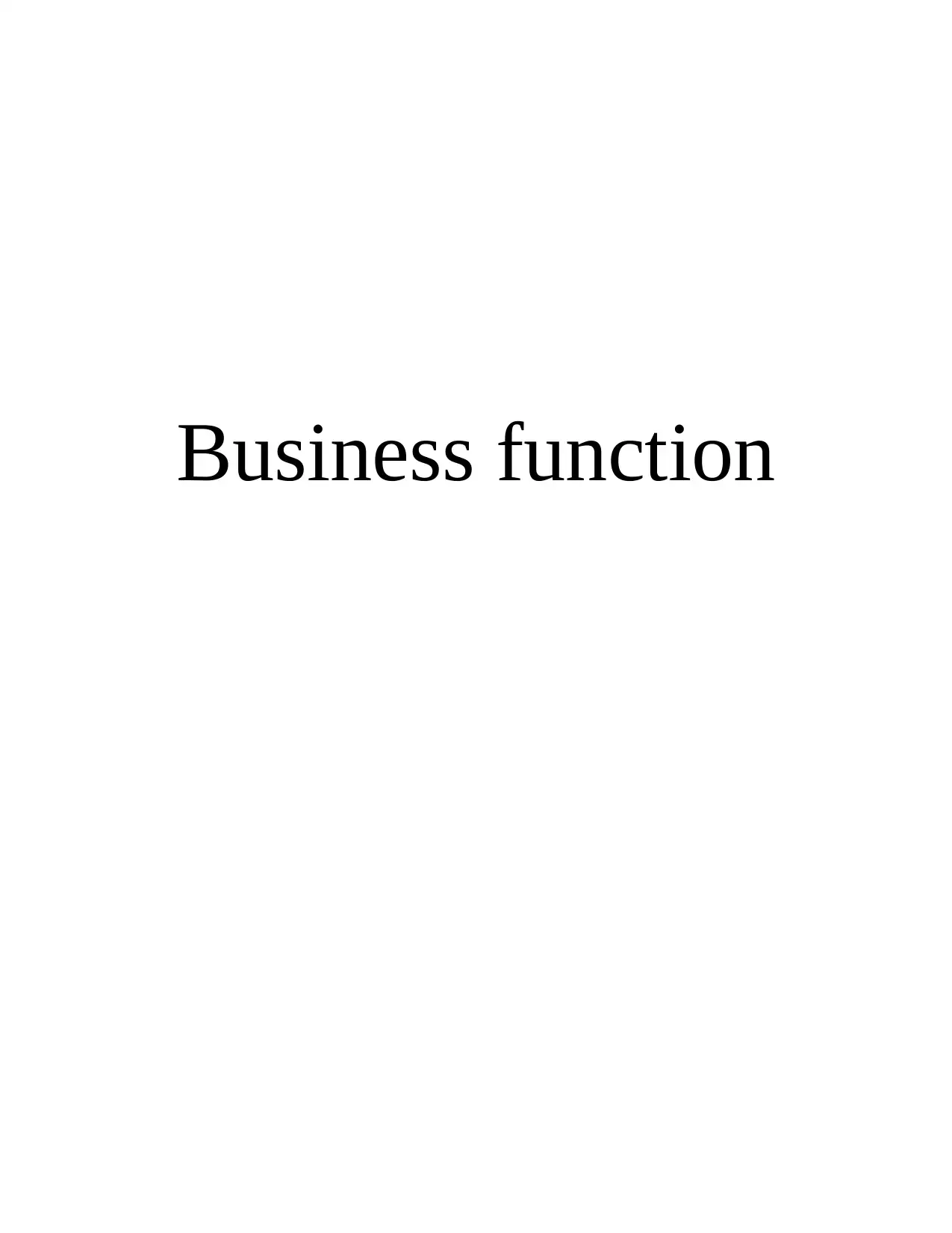
Business function
Paraphrase This Document
Need a fresh take? Get an instant paraphrase of this document with our AI Paraphraser
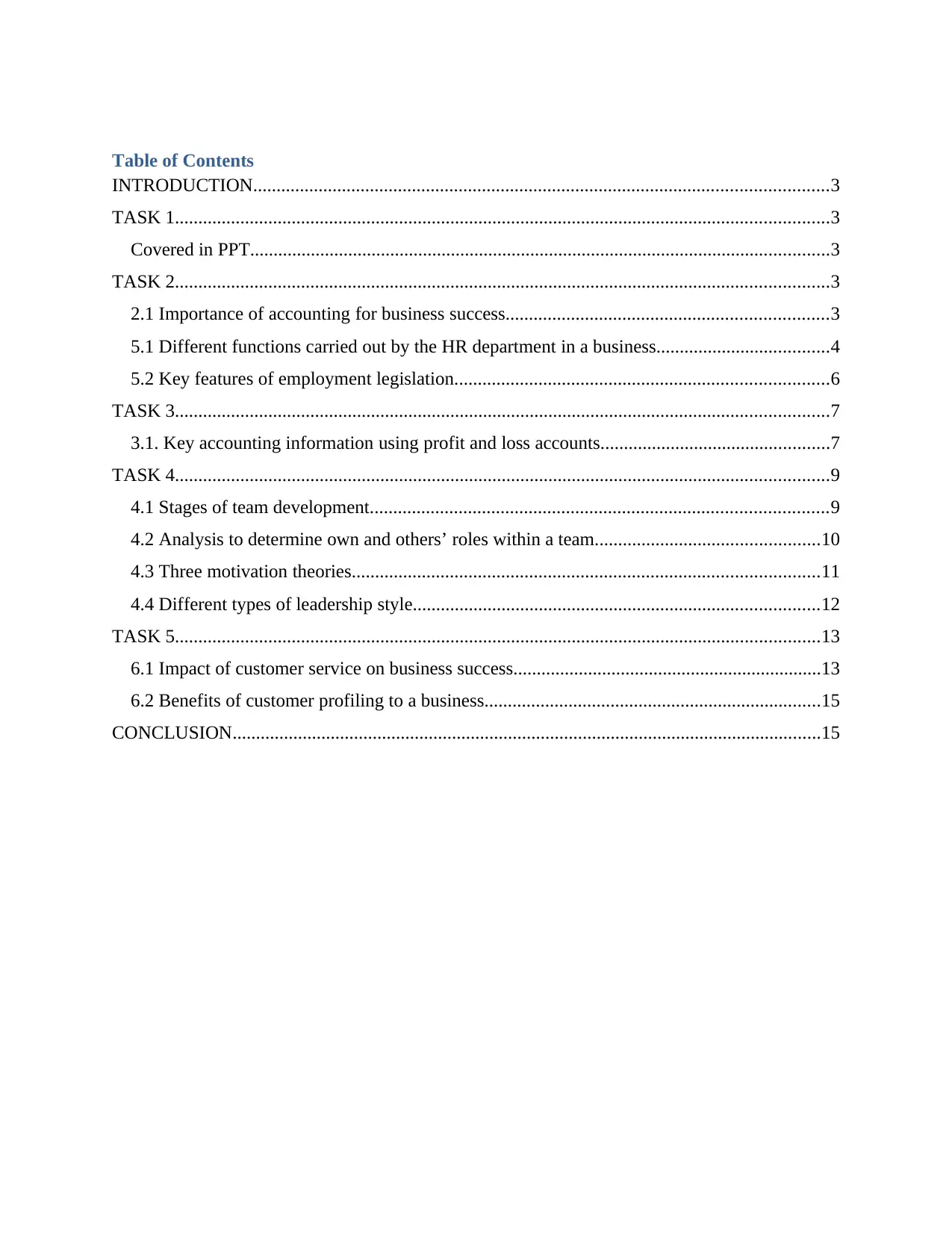
Table of Contents
INTRODUCTION...........................................................................................................................3
TASK 1............................................................................................................................................3
Covered in PPT............................................................................................................................3
TASK 2............................................................................................................................................3
2.1 Importance of accounting for business success.....................................................................3
5.1 Different functions carried out by the HR department in a business.....................................4
5.2 Key features of employment legislation................................................................................6
TASK 3............................................................................................................................................7
3.1. Key accounting information using profit and loss accounts.................................................7
TASK 4............................................................................................................................................9
4.1 Stages of team development..................................................................................................9
4.2 Analysis to determine own and others’ roles within a team................................................10
4.3 Three motivation theories....................................................................................................11
4.4 Different types of leadership style.......................................................................................12
TASK 5..........................................................................................................................................13
6.1 Impact of customer service on business success..................................................................13
6.2 Benefits of customer profiling to a business........................................................................15
CONCLUSION..............................................................................................................................15
INTRODUCTION...........................................................................................................................3
TASK 1............................................................................................................................................3
Covered in PPT............................................................................................................................3
TASK 2............................................................................................................................................3
2.1 Importance of accounting for business success.....................................................................3
5.1 Different functions carried out by the HR department in a business.....................................4
5.2 Key features of employment legislation................................................................................6
TASK 3............................................................................................................................................7
3.1. Key accounting information using profit and loss accounts.................................................7
TASK 4............................................................................................................................................9
4.1 Stages of team development..................................................................................................9
4.2 Analysis to determine own and others’ roles within a team................................................10
4.3 Three motivation theories....................................................................................................11
4.4 Different types of leadership style.......................................................................................12
TASK 5..........................................................................................................................................13
6.1 Impact of customer service on business success..................................................................13
6.2 Benefits of customer profiling to a business........................................................................15
CONCLUSION..............................................................................................................................15
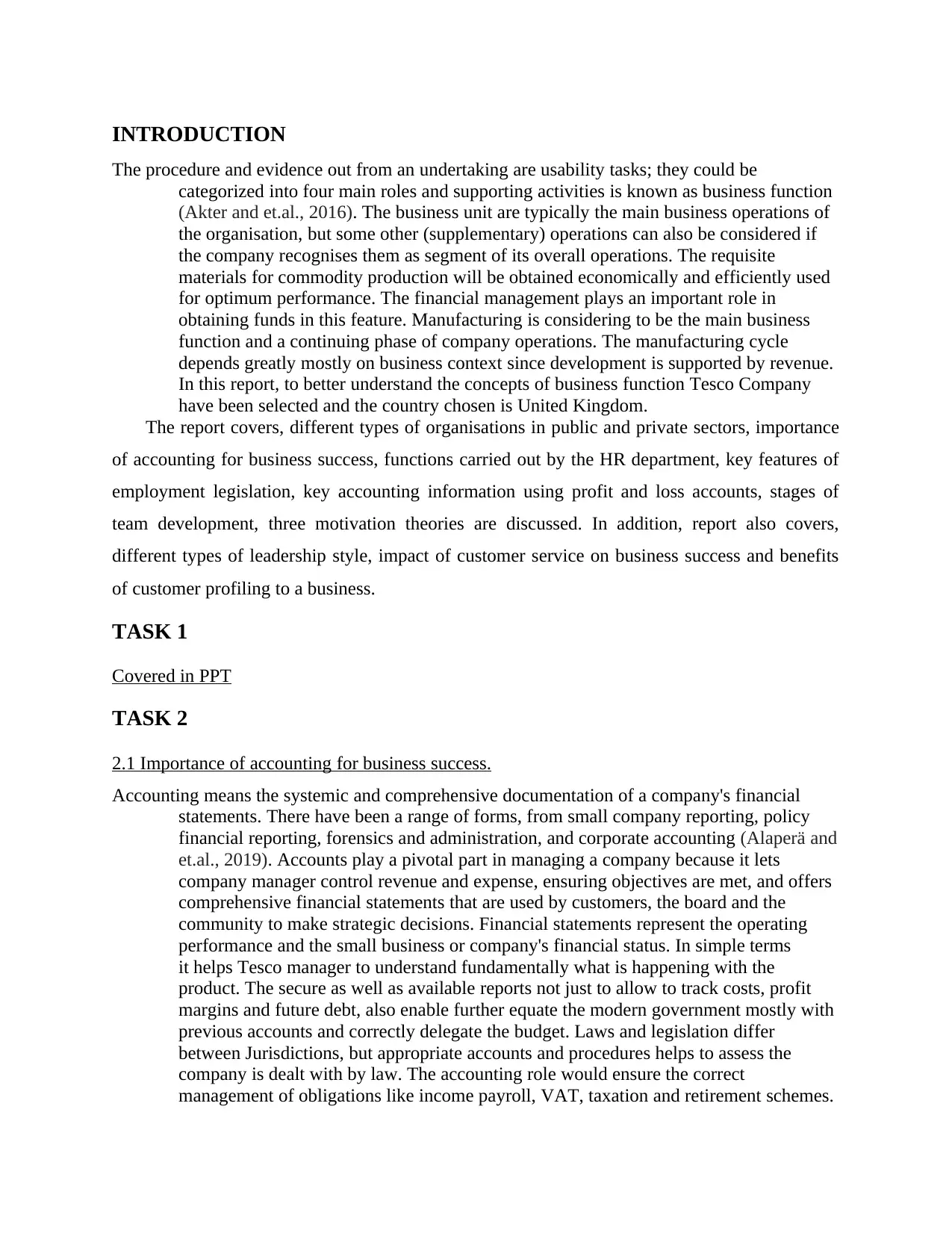
INTRODUCTION
The procedure and evidence out from an undertaking are usability tasks; they could be
categorized into four main roles and supporting activities is known as business function
(Akter and et.al., 2016). The business unit are typically the main business operations of
the organisation, but some other (supplementary) operations can also be considered if
the company recognises them as segment of its overall operations. The requisite
materials for commodity production will be obtained economically and efficiently used
for optimum performance. The financial management plays an important role in
obtaining funds in this feature. Manufacturing is considering to be the main business
function and a continuing phase of company operations. The manufacturing cycle
depends greatly mostly on business context since development is supported by revenue.
In this report, to better understand the concepts of business function Tesco Company
have been selected and the country chosen is United Kingdom.
The report covers, different types of organisations in public and private sectors, importance
of accounting for business success, functions carried out by the HR department, key features of
employment legislation, key accounting information using profit and loss accounts, stages of
team development, three motivation theories are discussed. In addition, report also covers,
different types of leadership style, impact of customer service on business success and benefits
of customer profiling to a business.
TASK 1
Covered in PPT
TASK 2
2.1 Importance of accounting for business success.
Accounting means the systemic and comprehensive documentation of a company's financial
statements. There have been a range of forms, from small company reporting, policy
financial reporting, forensics and administration, and corporate accounting (Alaperä and
et.al., 2019). Accounts play a pivotal part in managing a company because it lets
company manager control revenue and expense, ensuring objectives are met, and offers
comprehensive financial statements that are used by customers, the board and the
community to make strategic decisions. Financial statements represent the operating
performance and the small business or company's financial status. In simple terms
it helps Tesco manager to understand fundamentally what is happening with the
product. The secure as well as available reports not just to allow to track costs, profit
margins and future debt, also enable further equate the modern government mostly with
previous accounts and correctly delegate the budget. Laws and legislation differ
between Jurisdictions, but appropriate accounts and procedures helps to assess the
company is dealt with by law. The accounting role would ensure the correct
management of obligations like income payroll, VAT, taxation and retirement schemes.
The procedure and evidence out from an undertaking are usability tasks; they could be
categorized into four main roles and supporting activities is known as business function
(Akter and et.al., 2016). The business unit are typically the main business operations of
the organisation, but some other (supplementary) operations can also be considered if
the company recognises them as segment of its overall operations. The requisite
materials for commodity production will be obtained economically and efficiently used
for optimum performance. The financial management plays an important role in
obtaining funds in this feature. Manufacturing is considering to be the main business
function and a continuing phase of company operations. The manufacturing cycle
depends greatly mostly on business context since development is supported by revenue.
In this report, to better understand the concepts of business function Tesco Company
have been selected and the country chosen is United Kingdom.
The report covers, different types of organisations in public and private sectors, importance
of accounting for business success, functions carried out by the HR department, key features of
employment legislation, key accounting information using profit and loss accounts, stages of
team development, three motivation theories are discussed. In addition, report also covers,
different types of leadership style, impact of customer service on business success and benefits
of customer profiling to a business.
TASK 1
Covered in PPT
TASK 2
2.1 Importance of accounting for business success.
Accounting means the systemic and comprehensive documentation of a company's financial
statements. There have been a range of forms, from small company reporting, policy
financial reporting, forensics and administration, and corporate accounting (Alaperä and
et.al., 2019). Accounts play a pivotal part in managing a company because it lets
company manager control revenue and expense, ensuring objectives are met, and offers
comprehensive financial statements that are used by customers, the board and the
community to make strategic decisions. Financial statements represent the operating
performance and the small business or company's financial status. In simple terms
it helps Tesco manager to understand fundamentally what is happening with the
product. The secure as well as available reports not just to allow to track costs, profit
margins and future debt, also enable further equate the modern government mostly with
previous accounts and correctly delegate the budget. Laws and legislation differ
between Jurisdictions, but appropriate accounts and procedures helps to assess the
company is dealt with by law. The accounting role would ensure the correct
management of obligations like income payroll, VAT, taxation and retirement schemes.
⊘ This is a preview!⊘
Do you want full access?
Subscribe today to unlock all pages.

Trusted by 1+ million students worldwide
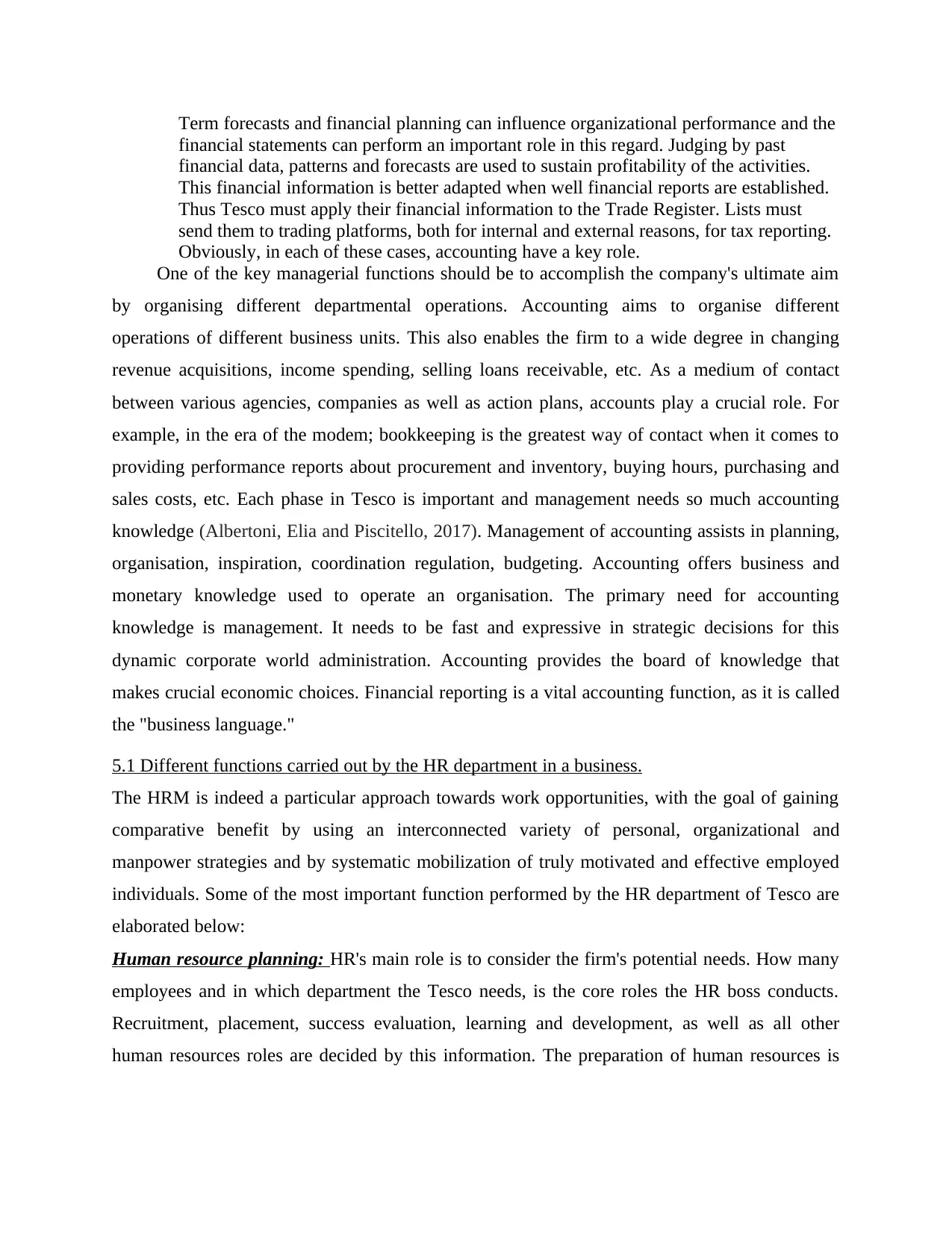
Term forecasts and financial planning can influence organizational performance and the
financial statements can perform an important role in this regard. Judging by past
financial data, patterns and forecasts are used to sustain profitability of the activities.
This financial information is better adapted when well financial reports are established.
Thus Tesco must apply their financial information to the Trade Register. Lists must
send them to trading platforms, both for internal and external reasons, for tax reporting.
Obviously, in each of these cases, accounting have a key role.
One of the key managerial functions should be to accomplish the company's ultimate aim
by organising different departmental operations. Accounting aims to organise different
operations of different business units. This also enables the firm to a wide degree in changing
revenue acquisitions, income spending, selling loans receivable, etc. As a medium of contact
between various agencies, companies as well as action plans, accounts play a crucial role. For
example, in the era of the modem; bookkeeping is the greatest way of contact when it comes to
providing performance reports about procurement and inventory, buying hours, purchasing and
sales costs, etc. Each phase in Tesco is important and management needs so much accounting
knowledge (Albertoni, Elia and Piscitello, 2017). Management of accounting assists in planning,
organisation, inspiration, coordination regulation, budgeting. Accounting offers business and
monetary knowledge used to operate an organisation. The primary need for accounting
knowledge is management. It needs to be fast and expressive in strategic decisions for this
dynamic corporate world administration. Accounting provides the board of knowledge that
makes crucial economic choices. Financial reporting is a vital accounting function, as it is called
the "business language."
5.1 Different functions carried out by the HR department in a business.
The HRM is indeed a particular approach towards work opportunities, with the goal of gaining
comparative benefit by using an interconnected variety of personal, organizational and
manpower strategies and by systematic mobilization of truly motivated and effective employed
individuals. Some of the most important function performed by the HR department of Tesco are
elaborated below:
Human resource planning: HR's main role is to consider the firm's potential needs. How many
employees and in which department the Tesco needs, is the core roles the HR boss conducts.
Recruitment, placement, success evaluation, learning and development, as well as all other
human resources roles are decided by this information. The preparation of human resources is
financial statements can perform an important role in this regard. Judging by past
financial data, patterns and forecasts are used to sustain profitability of the activities.
This financial information is better adapted when well financial reports are established.
Thus Tesco must apply their financial information to the Trade Register. Lists must
send them to trading platforms, both for internal and external reasons, for tax reporting.
Obviously, in each of these cases, accounting have a key role.
One of the key managerial functions should be to accomplish the company's ultimate aim
by organising different departmental operations. Accounting aims to organise different
operations of different business units. This also enables the firm to a wide degree in changing
revenue acquisitions, income spending, selling loans receivable, etc. As a medium of contact
between various agencies, companies as well as action plans, accounts play a crucial role. For
example, in the era of the modem; bookkeeping is the greatest way of contact when it comes to
providing performance reports about procurement and inventory, buying hours, purchasing and
sales costs, etc. Each phase in Tesco is important and management needs so much accounting
knowledge (Albertoni, Elia and Piscitello, 2017). Management of accounting assists in planning,
organisation, inspiration, coordination regulation, budgeting. Accounting offers business and
monetary knowledge used to operate an organisation. The primary need for accounting
knowledge is management. It needs to be fast and expressive in strategic decisions for this
dynamic corporate world administration. Accounting provides the board of knowledge that
makes crucial economic choices. Financial reporting is a vital accounting function, as it is called
the "business language."
5.1 Different functions carried out by the HR department in a business.
The HRM is indeed a particular approach towards work opportunities, with the goal of gaining
comparative benefit by using an interconnected variety of personal, organizational and
manpower strategies and by systematic mobilization of truly motivated and effective employed
individuals. Some of the most important function performed by the HR department of Tesco are
elaborated below:
Human resource planning: HR's main role is to consider the firm's potential needs. How many
employees and in which department the Tesco needs, is the core roles the HR boss conducts.
Recruitment, placement, success evaluation, learning and development, as well as all other
human resources roles are decided by this information. The preparation of human resources is
Paraphrase This Document
Need a fresh take? Get an instant paraphrase of this document with our AI Paraphraser
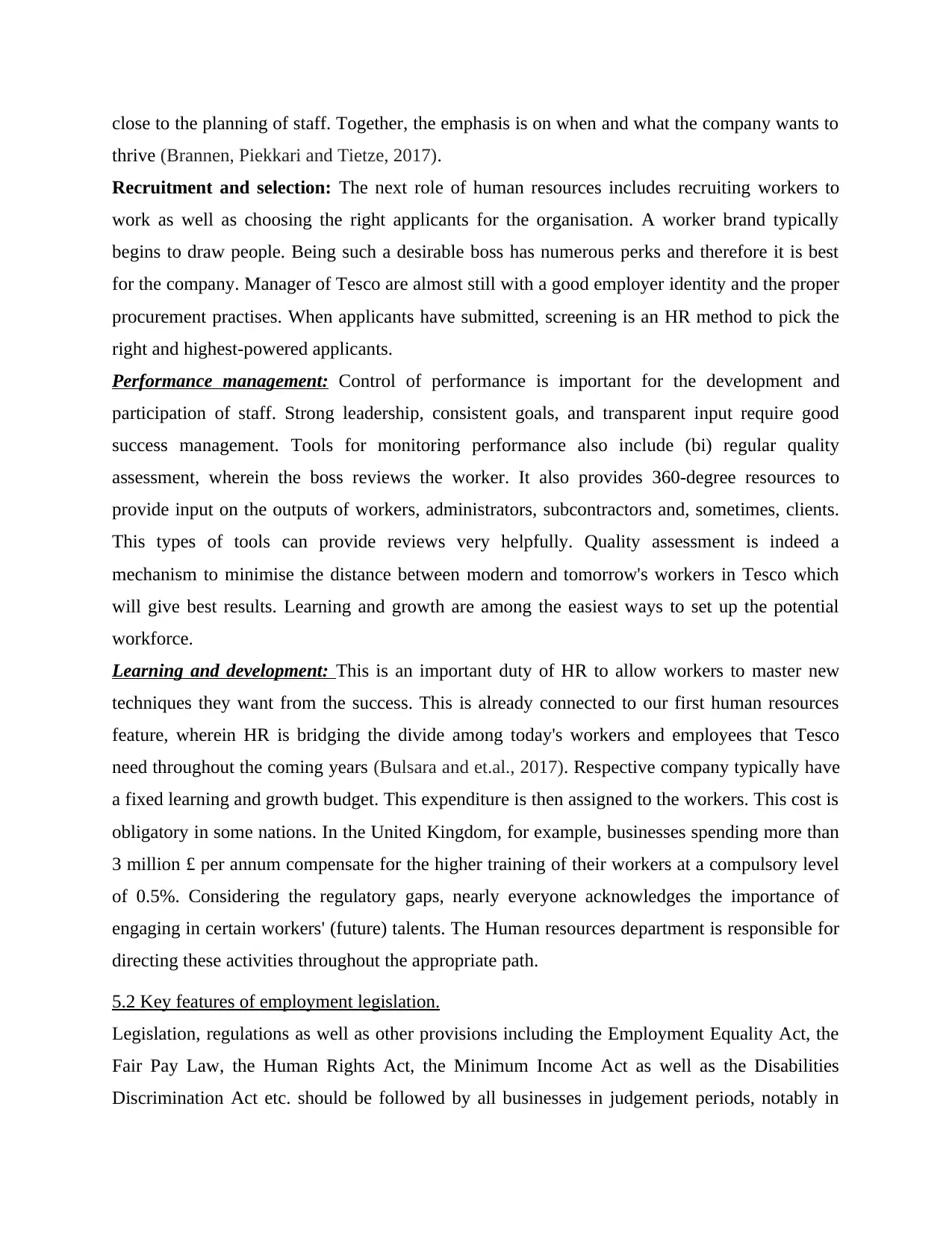
close to the planning of staff. Together, the emphasis is on when and what the company wants to
thrive (Brannen, Piekkari and Tietze, 2017).
Recruitment and selection: The next role of human resources includes recruiting workers to
work as well as choosing the right applicants for the organisation. A worker brand typically
begins to draw people. Being such a desirable boss has numerous perks and therefore it is best
for the company. Manager of Tesco are almost still with a good employer identity and the proper
procurement practises. When applicants have submitted, screening is an HR method to pick the
right and highest-powered applicants.
Performance management: Control of performance is important for the development and
participation of staff. Strong leadership, consistent goals, and transparent input require good
success management. Tools for monitoring performance also include (bi) regular quality
assessment, wherein the boss reviews the worker. It also provides 360-degree resources to
provide input on the outputs of workers, administrators, subcontractors and, sometimes, clients.
This types of tools can provide reviews very helpfully. Quality assessment is indeed a
mechanism to minimise the distance between modern and tomorrow's workers in Tesco which
will give best results. Learning and growth are among the easiest ways to set up the potential
workforce.
Learning and development: This is an important duty of HR to allow workers to master new
techniques they want from the success. This is already connected to our first human resources
feature, wherein HR is bridging the divide among today's workers and employees that Tesco
need throughout the coming years (Bulsara and et.al., 2017). Respective company typically have
a fixed learning and growth budget. This expenditure is then assigned to the workers. This cost is
obligatory in some nations. In the United Kingdom, for example, businesses spending more than
3 million £ per annum compensate for the higher training of their workers at a compulsory level
of 0.5%. Considering the regulatory gaps, nearly everyone acknowledges the importance of
engaging in certain workers' (future) talents. The Human resources department is responsible for
directing these activities throughout the appropriate path.
5.2 Key features of employment legislation.
Legislation, regulations as well as other provisions including the Employment Equality Act, the
Fair Pay Law, the Human Rights Act, the Minimum Income Act as well as the Disabilities
Discrimination Act etc. should be followed by all businesses in judgement periods, notably in
thrive (Brannen, Piekkari and Tietze, 2017).
Recruitment and selection: The next role of human resources includes recruiting workers to
work as well as choosing the right applicants for the organisation. A worker brand typically
begins to draw people. Being such a desirable boss has numerous perks and therefore it is best
for the company. Manager of Tesco are almost still with a good employer identity and the proper
procurement practises. When applicants have submitted, screening is an HR method to pick the
right and highest-powered applicants.
Performance management: Control of performance is important for the development and
participation of staff. Strong leadership, consistent goals, and transparent input require good
success management. Tools for monitoring performance also include (bi) regular quality
assessment, wherein the boss reviews the worker. It also provides 360-degree resources to
provide input on the outputs of workers, administrators, subcontractors and, sometimes, clients.
This types of tools can provide reviews very helpfully. Quality assessment is indeed a
mechanism to minimise the distance between modern and tomorrow's workers in Tesco which
will give best results. Learning and growth are among the easiest ways to set up the potential
workforce.
Learning and development: This is an important duty of HR to allow workers to master new
techniques they want from the success. This is already connected to our first human resources
feature, wherein HR is bridging the divide among today's workers and employees that Tesco
need throughout the coming years (Bulsara and et.al., 2017). Respective company typically have
a fixed learning and growth budget. This expenditure is then assigned to the workers. This cost is
obligatory in some nations. In the United Kingdom, for example, businesses spending more than
3 million £ per annum compensate for the higher training of their workers at a compulsory level
of 0.5%. Considering the regulatory gaps, nearly everyone acknowledges the importance of
engaging in certain workers' (future) talents. The Human resources department is responsible for
directing these activities throughout the appropriate path.
5.2 Key features of employment legislation.
Legislation, regulations as well as other provisions including the Employment Equality Act, the
Fair Pay Law, the Human Rights Act, the Minimum Income Act as well as the Disabilities
Discrimination Act etc. should be followed by all businesses in judgement periods, notably in
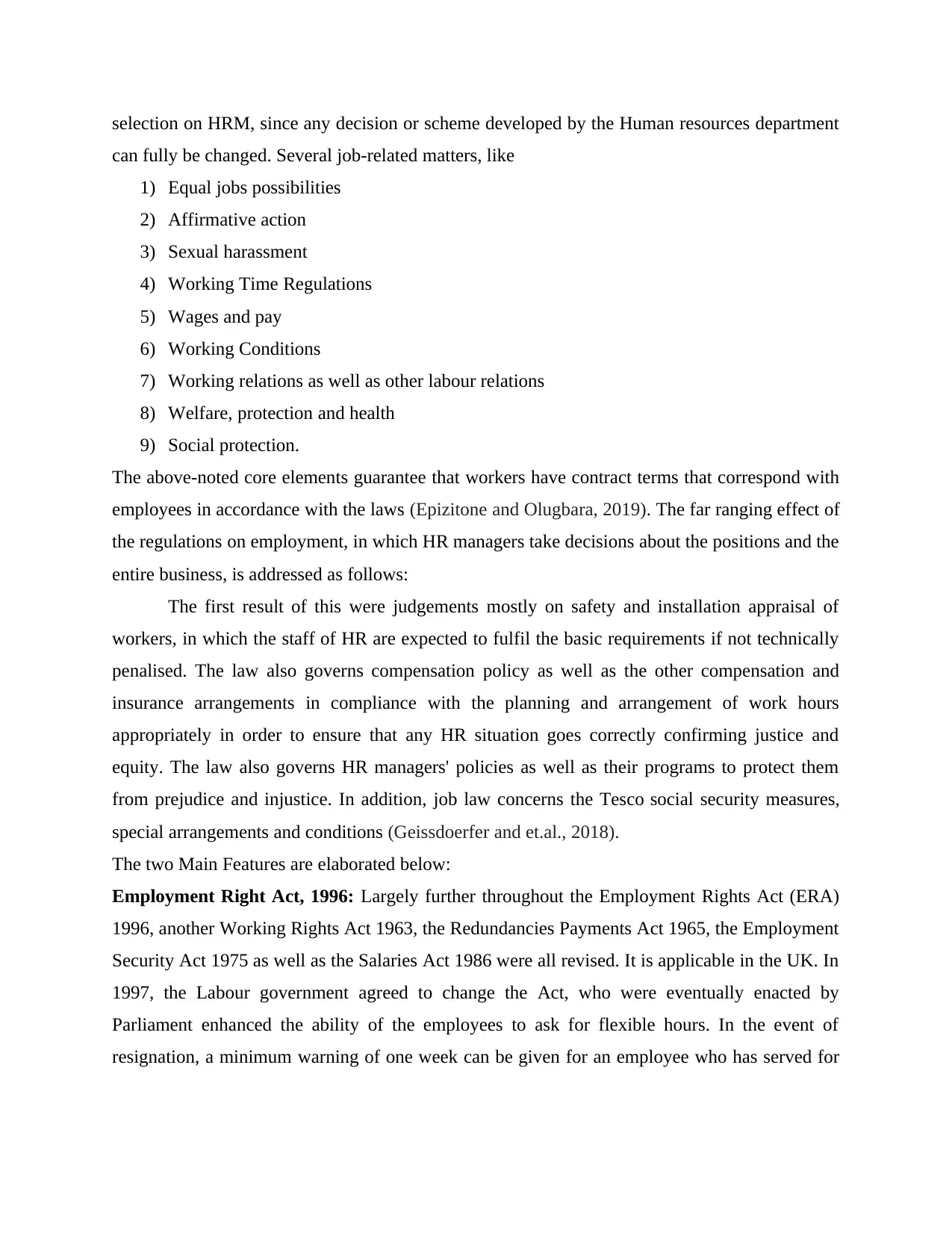
selection on HRM, since any decision or scheme developed by the Human resources department
can fully be changed. Several job-related matters, like
1) Equal jobs possibilities
2) Affirmative action
3) Sexual harassment
4) Working Time Regulations
5) Wages and pay
6) Working Conditions
7) Working relations as well as other labour relations
8) Welfare, protection and health
9) Social protection.
The above-noted core elements guarantee that workers have contract terms that correspond with
employees in accordance with the laws (Epizitone and Olugbara, 2019). The far ranging effect of
the regulations on employment, in which HR managers take decisions about the positions and the
entire business, is addressed as follows:
The first result of this were judgements mostly on safety and installation appraisal of
workers, in which the staff of HR are expected to fulfil the basic requirements if not technically
penalised. The law also governs compensation policy as well as the other compensation and
insurance arrangements in compliance with the planning and arrangement of work hours
appropriately in order to ensure that any HR situation goes correctly confirming justice and
equity. The law also governs HR managers' policies as well as their programs to protect them
from prejudice and injustice. In addition, job law concerns the Tesco social security measures,
special arrangements and conditions (Geissdoerfer and et.al., 2018).
The two Main Features are elaborated below:
Employment Right Act, 1996: Largely further throughout the Employment Rights Act (ERA)
1996, another Working Rights Act 1963, the Redundancies Payments Act 1965, the Employment
Security Act 1975 as well as the Salaries Act 1986 were all revised. It is applicable in the UK. In
1997, the Labour government agreed to change the Act, who were eventually enacted by
Parliament enhanced the ability of the employees to ask for flexible hours. In the event of
resignation, a minimum warning of one week can be given for an employee who has served for
can fully be changed. Several job-related matters, like
1) Equal jobs possibilities
2) Affirmative action
3) Sexual harassment
4) Working Time Regulations
5) Wages and pay
6) Working Conditions
7) Working relations as well as other labour relations
8) Welfare, protection and health
9) Social protection.
The above-noted core elements guarantee that workers have contract terms that correspond with
employees in accordance with the laws (Epizitone and Olugbara, 2019). The far ranging effect of
the regulations on employment, in which HR managers take decisions about the positions and the
entire business, is addressed as follows:
The first result of this were judgements mostly on safety and installation appraisal of
workers, in which the staff of HR are expected to fulfil the basic requirements if not technically
penalised. The law also governs compensation policy as well as the other compensation and
insurance arrangements in compliance with the planning and arrangement of work hours
appropriately in order to ensure that any HR situation goes correctly confirming justice and
equity. The law also governs HR managers' policies as well as their programs to protect them
from prejudice and injustice. In addition, job law concerns the Tesco social security measures,
special arrangements and conditions (Geissdoerfer and et.al., 2018).
The two Main Features are elaborated below:
Employment Right Act, 1996: Largely further throughout the Employment Rights Act (ERA)
1996, another Working Rights Act 1963, the Redundancies Payments Act 1965, the Employment
Security Act 1975 as well as the Salaries Act 1986 were all revised. It is applicable in the UK. In
1997, the Labour government agreed to change the Act, who were eventually enacted by
Parliament enhanced the ability of the employees to ask for flexible hours. In the event of
resignation, a minimum warning of one week can be given for an employee who has served for
⊘ This is a preview!⊘
Do you want full access?
Subscribe today to unlock all pages.

Trusted by 1+ million students worldwide
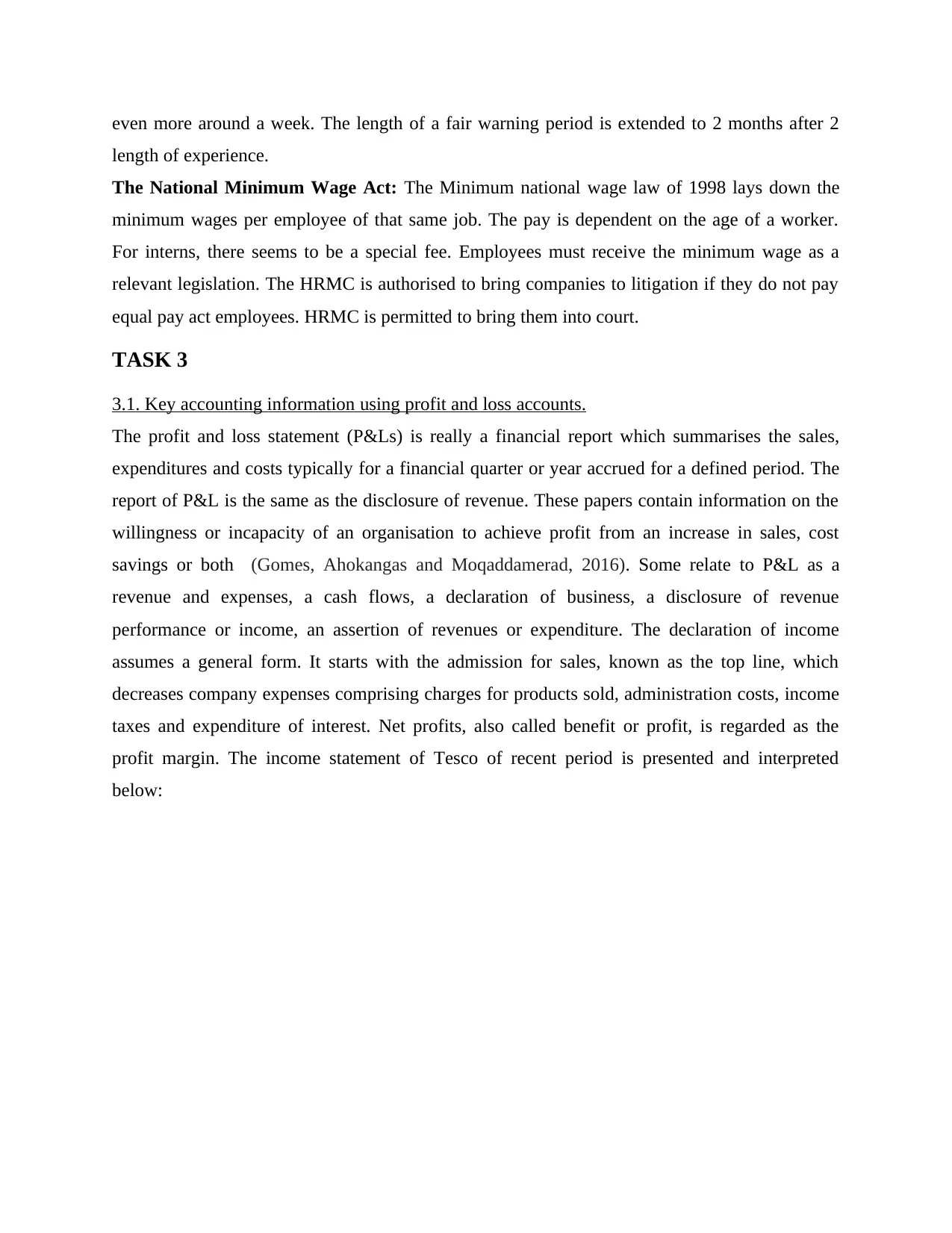
even more around a week. The length of a fair warning period is extended to 2 months after 2
length of experience.
The National Minimum Wage Act: The Minimum national wage law of 1998 lays down the
minimum wages per employee of that same job. The pay is dependent on the age of a worker.
For interns, there seems to be a special fee. Employees must receive the minimum wage as a
relevant legislation. The HRMC is authorised to bring companies to litigation if they do not pay
equal pay act employees. HRMC is permitted to bring them into court.
TASK 3
3.1. Key accounting information using profit and loss accounts.
The profit and loss statement (P&Ls) is really a financial report which summarises the sales,
expenditures and costs typically for a financial quarter or year accrued for a defined period. The
report of P&L is the same as the disclosure of revenue. These papers contain information on the
willingness or incapacity of an organisation to achieve profit from an increase in sales, cost
savings or both (Gomes, Ahokangas and Moqaddamerad, 2016). Some relate to P&L as a
revenue and expenses, a cash flows, a declaration of business, a disclosure of revenue
performance or income, an assertion of revenues or expenditure. The declaration of income
assumes a general form. It starts with the admission for sales, known as the top line, which
decreases company expenses comprising charges for products sold, administration costs, income
taxes and expenditure of interest. Net profits, also called benefit or profit, is regarded as the
profit margin. The income statement of Tesco of recent period is presented and interpreted
below:
length of experience.
The National Minimum Wage Act: The Minimum national wage law of 1998 lays down the
minimum wages per employee of that same job. The pay is dependent on the age of a worker.
For interns, there seems to be a special fee. Employees must receive the minimum wage as a
relevant legislation. The HRMC is authorised to bring companies to litigation if they do not pay
equal pay act employees. HRMC is permitted to bring them into court.
TASK 3
3.1. Key accounting information using profit and loss accounts.
The profit and loss statement (P&Ls) is really a financial report which summarises the sales,
expenditures and costs typically for a financial quarter or year accrued for a defined period. The
report of P&L is the same as the disclosure of revenue. These papers contain information on the
willingness or incapacity of an organisation to achieve profit from an increase in sales, cost
savings or both (Gomes, Ahokangas and Moqaddamerad, 2016). Some relate to P&L as a
revenue and expenses, a cash flows, a declaration of business, a disclosure of revenue
performance or income, an assertion of revenues or expenditure. The declaration of income
assumes a general form. It starts with the admission for sales, known as the top line, which
decreases company expenses comprising charges for products sold, administration costs, income
taxes and expenditure of interest. Net profits, also called benefit or profit, is regarded as the
profit margin. The income statement of Tesco of recent period is presented and interpreted
below:
Paraphrase This Document
Need a fresh take? Get an instant paraphrase of this document with our AI Paraphraser
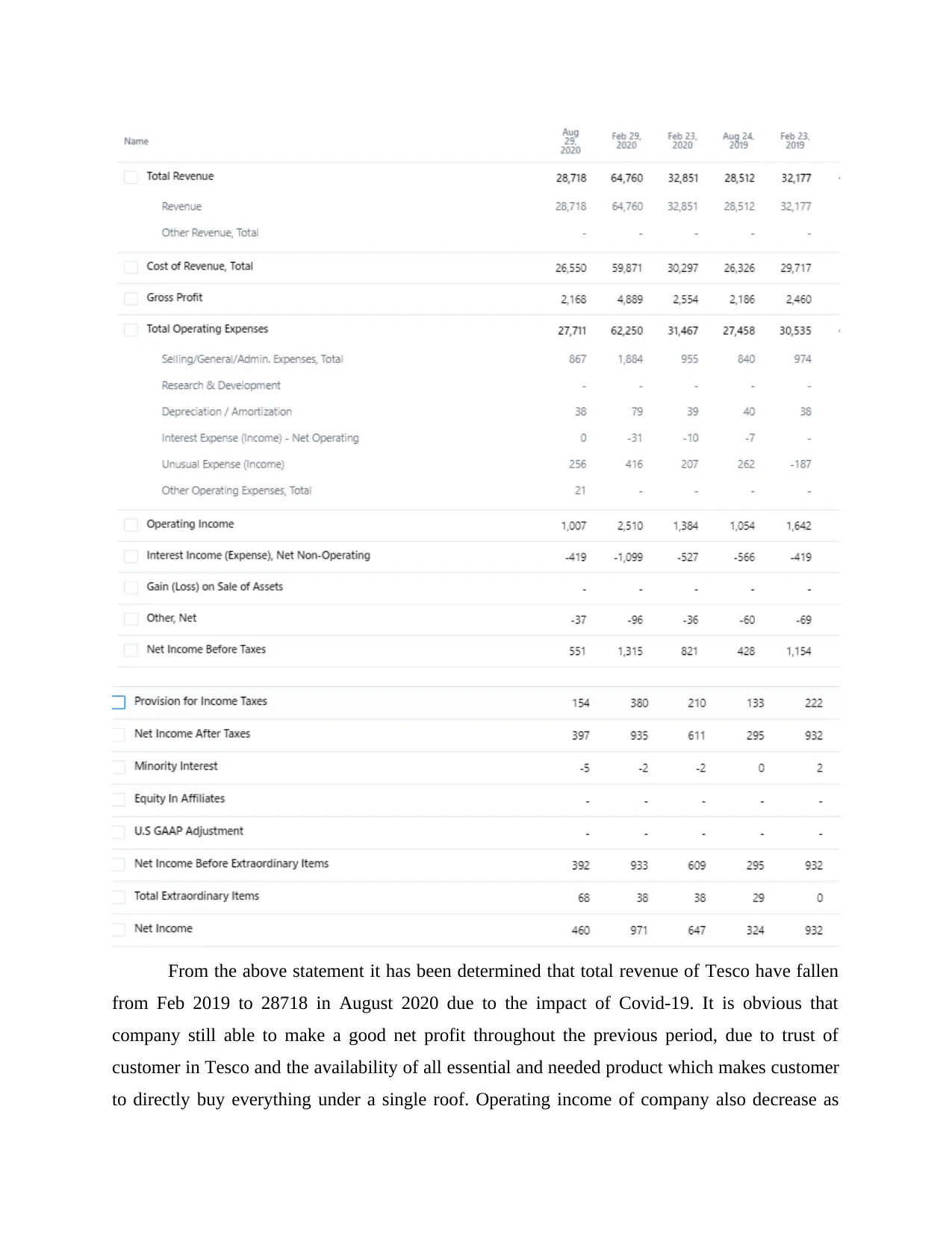
From the above statement it has been determined that total revenue of Tesco have fallen
from Feb 2019 to 28718 in August 2020 due to the impact of Covid-19. It is obvious that
company still able to make a good net profit throughout the previous period, due to trust of
customer in Tesco and the availability of all essential and needed product which makes customer
to directly buy everything under a single roof. Operating income of company also decrease as
from Feb 2019 to 28718 in August 2020 due to the impact of Covid-19. It is obvious that
company still able to make a good net profit throughout the previous period, due to trust of
customer in Tesco and the availability of all essential and needed product which makes customer
to directly buy everything under a single roof. Operating income of company also decrease as
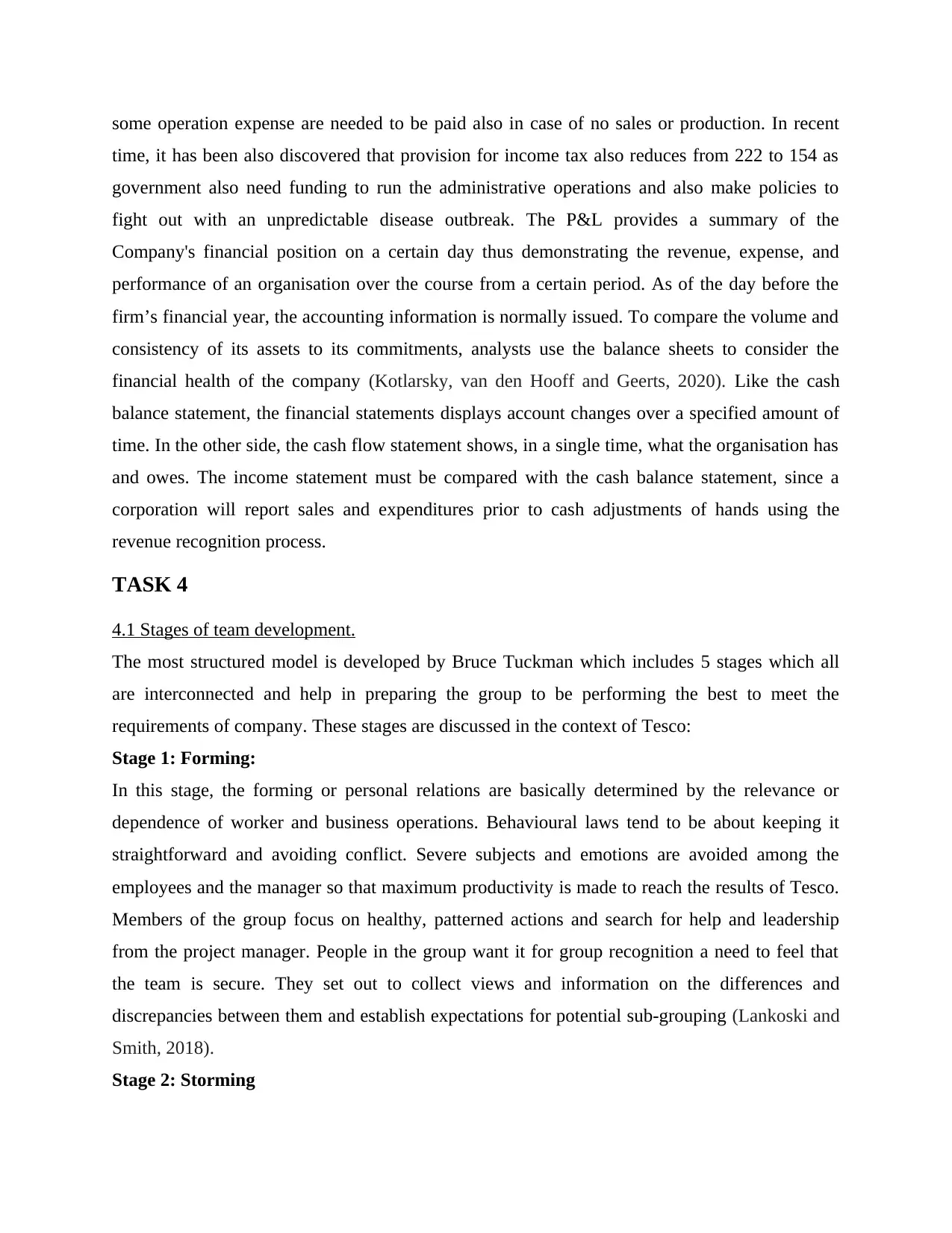
some operation expense are needed to be paid also in case of no sales or production. In recent
time, it has been also discovered that provision for income tax also reduces from 222 to 154 as
government also need funding to run the administrative operations and also make policies to
fight out with an unpredictable disease outbreak. The P&L provides a summary of the
Company's financial position on a certain day thus demonstrating the revenue, expense, and
performance of an organisation over the course from a certain period. As of the day before the
firm’s financial year, the accounting information is normally issued. To compare the volume and
consistency of its assets to its commitments, analysts use the balance sheets to consider the
financial health of the company (Kotlarsky, van den Hooff and Geerts, 2020). Like the cash
balance statement, the financial statements displays account changes over a specified amount of
time. In the other side, the cash flow statement shows, in a single time, what the organisation has
and owes. The income statement must be compared with the cash balance statement, since a
corporation will report sales and expenditures prior to cash adjustments of hands using the
revenue recognition process.
TASK 4
4.1 Stages of team development.
The most structured model is developed by Bruce Tuckman which includes 5 stages which all
are interconnected and help in preparing the group to be performing the best to meet the
requirements of company. These stages are discussed in the context of Tesco:
Stage 1: Forming:
In this stage, the forming or personal relations are basically determined by the relevance or
dependence of worker and business operations. Behavioural laws tend to be about keeping it
straightforward and avoiding conflict. Severe subjects and emotions are avoided among the
employees and the manager so that maximum productivity is made to reach the results of Tesco.
Members of the group focus on healthy, patterned actions and search for help and leadership
from the project manager. People in the group want it for group recognition a need to feel that
the team is secure. They set out to collect views and information on the differences and
discrepancies between them and establish expectations for potential sub-grouping (Lankoski and
Smith, 2018).
Stage 2: Storming
time, it has been also discovered that provision for income tax also reduces from 222 to 154 as
government also need funding to run the administrative operations and also make policies to
fight out with an unpredictable disease outbreak. The P&L provides a summary of the
Company's financial position on a certain day thus demonstrating the revenue, expense, and
performance of an organisation over the course from a certain period. As of the day before the
firm’s financial year, the accounting information is normally issued. To compare the volume and
consistency of its assets to its commitments, analysts use the balance sheets to consider the
financial health of the company (Kotlarsky, van den Hooff and Geerts, 2020). Like the cash
balance statement, the financial statements displays account changes over a specified amount of
time. In the other side, the cash flow statement shows, in a single time, what the organisation has
and owes. The income statement must be compared with the cash balance statement, since a
corporation will report sales and expenditures prior to cash adjustments of hands using the
revenue recognition process.
TASK 4
4.1 Stages of team development.
The most structured model is developed by Bruce Tuckman which includes 5 stages which all
are interconnected and help in preparing the group to be performing the best to meet the
requirements of company. These stages are discussed in the context of Tesco:
Stage 1: Forming:
In this stage, the forming or personal relations are basically determined by the relevance or
dependence of worker and business operations. Behavioural laws tend to be about keeping it
straightforward and avoiding conflict. Severe subjects and emotions are avoided among the
employees and the manager so that maximum productivity is made to reach the results of Tesco.
Members of the group focus on healthy, patterned actions and search for help and leadership
from the project manager. People in the group want it for group recognition a need to feel that
the team is secure. They set out to collect views and information on the differences and
discrepancies between them and establish expectations for potential sub-grouping (Lankoski and
Smith, 2018).
Stage 2: Storming
⊘ This is a preview!⊘
Do you want full access?
Subscribe today to unlock all pages.

Trusted by 1+ million students worldwide
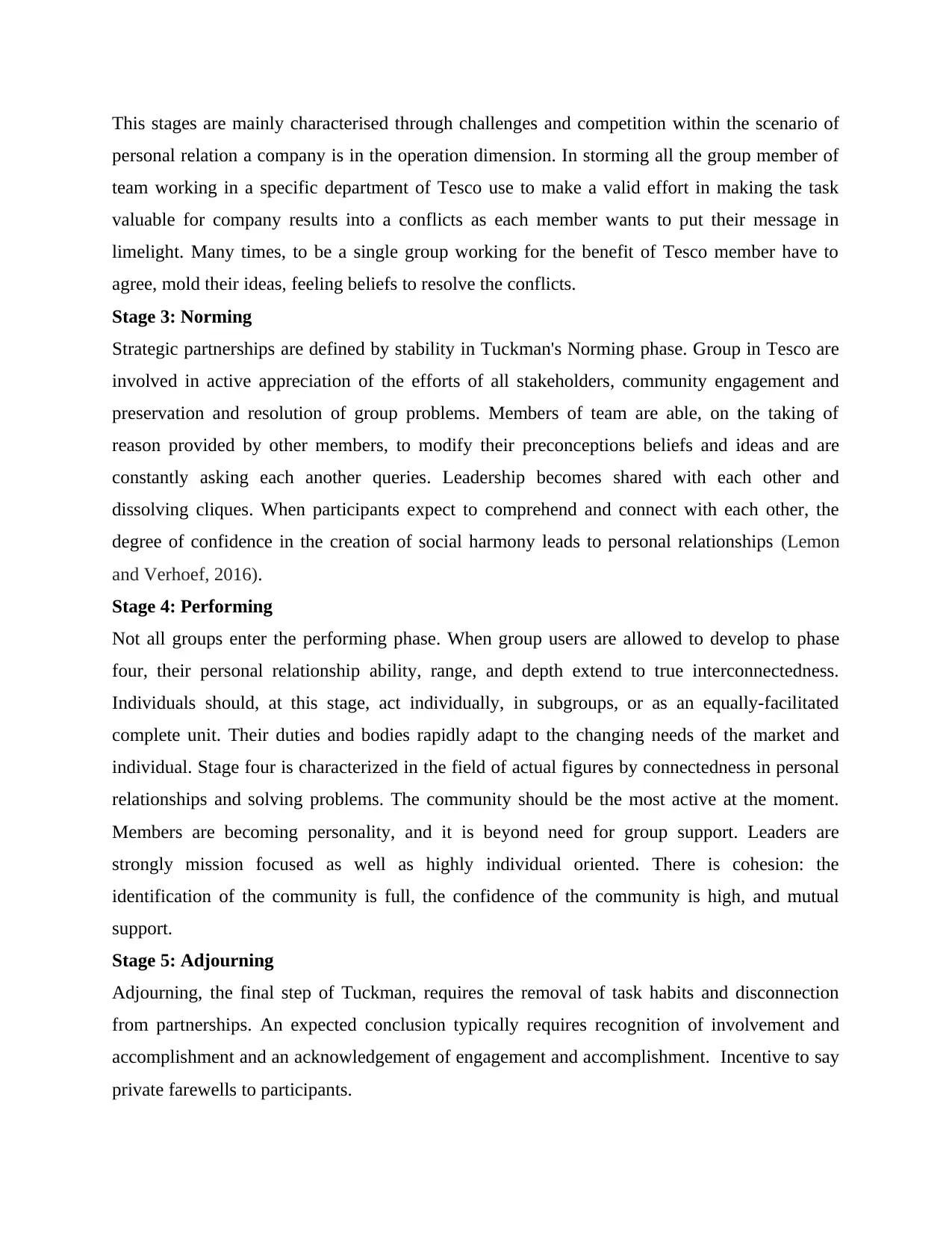
This stages are mainly characterised through challenges and competition within the scenario of
personal relation a company is in the operation dimension. In storming all the group member of
team working in a specific department of Tesco use to make a valid effort in making the task
valuable for company results into a conflicts as each member wants to put their message in
limelight. Many times, to be a single group working for the benefit of Tesco member have to
agree, mold their ideas, feeling beliefs to resolve the conflicts.
Stage 3: Norming
Strategic partnerships are defined by stability in Tuckman's Norming phase. Group in Tesco are
involved in active appreciation of the efforts of all stakeholders, community engagement and
preservation and resolution of group problems. Members of team are able, on the taking of
reason provided by other members, to modify their preconceptions beliefs and ideas and are
constantly asking each another queries. Leadership becomes shared with each other and
dissolving cliques. When participants expect to comprehend and connect with each other, the
degree of confidence in the creation of social harmony leads to personal relationships (Lemon
and Verhoef, 2016).
Stage 4: Performing
Not all groups enter the performing phase. When group users are allowed to develop to phase
four, their personal relationship ability, range, and depth extend to true interconnectedness.
Individuals should, at this stage, act individually, in subgroups, or as an equally-facilitated
complete unit. Their duties and bodies rapidly adapt to the changing needs of the market and
individual. Stage four is characterized in the field of actual figures by connectedness in personal
relationships and solving problems. The community should be the most active at the moment.
Members are becoming personality, and it is beyond need for group support. Leaders are
strongly mission focused as well as highly individual oriented. There is cohesion: the
identification of the community is full, the confidence of the community is high, and mutual
support.
Stage 5: Adjourning
Adjourning, the final step of Tuckman, requires the removal of task habits and disconnection
from partnerships. An expected conclusion typically requires recognition of involvement and
accomplishment and an acknowledgement of engagement and accomplishment. Incentive to say
private farewells to participants.
personal relation a company is in the operation dimension. In storming all the group member of
team working in a specific department of Tesco use to make a valid effort in making the task
valuable for company results into a conflicts as each member wants to put their message in
limelight. Many times, to be a single group working for the benefit of Tesco member have to
agree, mold their ideas, feeling beliefs to resolve the conflicts.
Stage 3: Norming
Strategic partnerships are defined by stability in Tuckman's Norming phase. Group in Tesco are
involved in active appreciation of the efforts of all stakeholders, community engagement and
preservation and resolution of group problems. Members of team are able, on the taking of
reason provided by other members, to modify their preconceptions beliefs and ideas and are
constantly asking each another queries. Leadership becomes shared with each other and
dissolving cliques. When participants expect to comprehend and connect with each other, the
degree of confidence in the creation of social harmony leads to personal relationships (Lemon
and Verhoef, 2016).
Stage 4: Performing
Not all groups enter the performing phase. When group users are allowed to develop to phase
four, their personal relationship ability, range, and depth extend to true interconnectedness.
Individuals should, at this stage, act individually, in subgroups, or as an equally-facilitated
complete unit. Their duties and bodies rapidly adapt to the changing needs of the market and
individual. Stage four is characterized in the field of actual figures by connectedness in personal
relationships and solving problems. The community should be the most active at the moment.
Members are becoming personality, and it is beyond need for group support. Leaders are
strongly mission focused as well as highly individual oriented. There is cohesion: the
identification of the community is full, the confidence of the community is high, and mutual
support.
Stage 5: Adjourning
Adjourning, the final step of Tuckman, requires the removal of task habits and disconnection
from partnerships. An expected conclusion typically requires recognition of involvement and
accomplishment and an acknowledgement of engagement and accomplishment. Incentive to say
private farewells to participants.
Paraphrase This Document
Need a fresh take? Get an instant paraphrase of this document with our AI Paraphraser
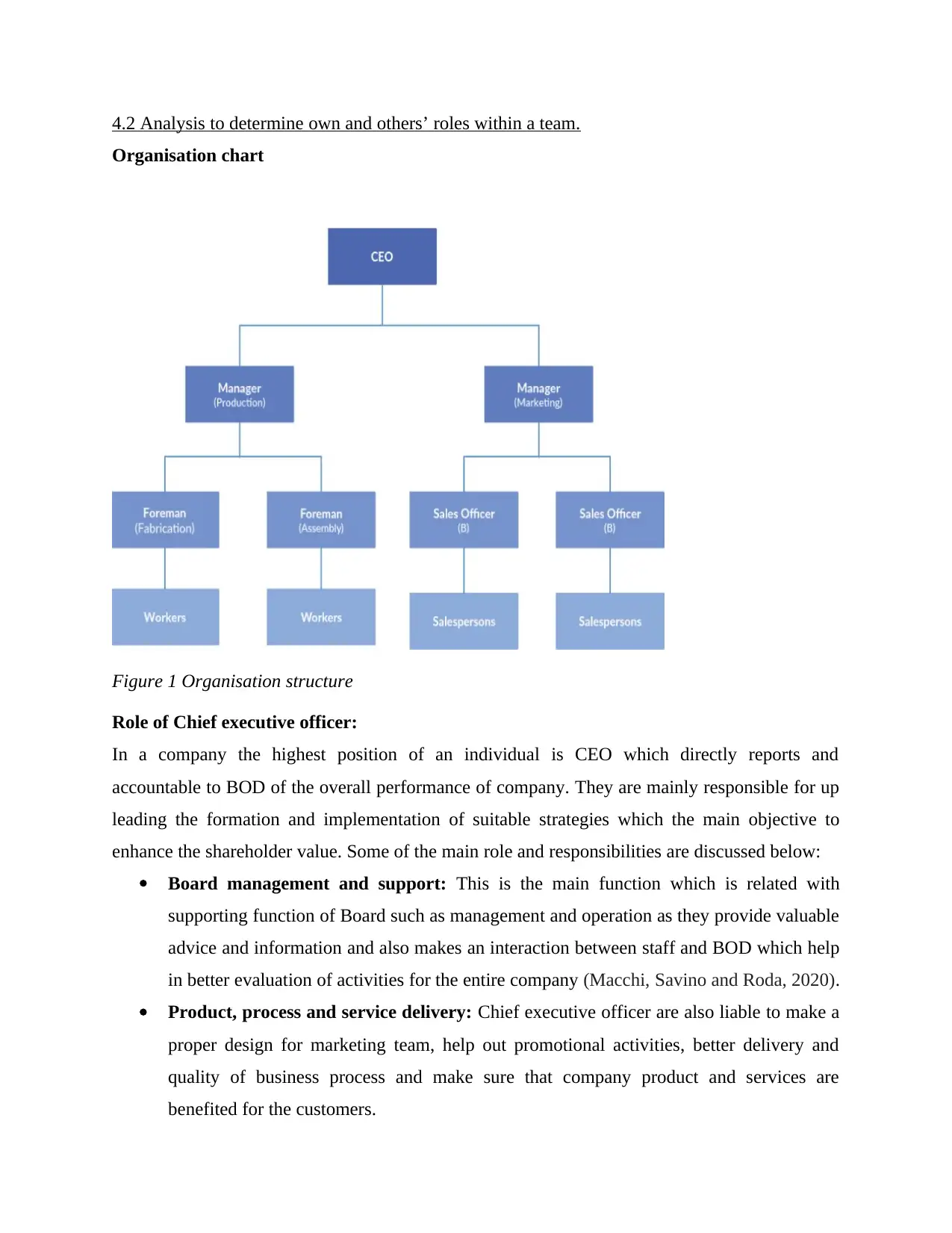
4.2 Analysis to determine own and others’ roles within a team.
Organisation chart
Figure 1 Organisation structure
Role of Chief executive officer:
In a company the highest position of an individual is CEO which directly reports and
accountable to BOD of the overall performance of company. They are mainly responsible for up
leading the formation and implementation of suitable strategies which the main objective to
enhance the shareholder value. Some of the main role and responsibilities are discussed below:
Board management and support: This is the main function which is related with
supporting function of Board such as management and operation as they provide valuable
advice and information and also makes an interaction between staff and BOD which help
in better evaluation of activities for the entire company (Macchi, Savino and Roda, 2020).
Product, process and service delivery: Chief executive officer are also liable to make a
proper design for marketing team, help out promotional activities, better delivery and
quality of business process and make sure that company product and services are
benefited for the customers.
Organisation chart
Figure 1 Organisation structure
Role of Chief executive officer:
In a company the highest position of an individual is CEO which directly reports and
accountable to BOD of the overall performance of company. They are mainly responsible for up
leading the formation and implementation of suitable strategies which the main objective to
enhance the shareholder value. Some of the main role and responsibilities are discussed below:
Board management and support: This is the main function which is related with
supporting function of Board such as management and operation as they provide valuable
advice and information and also makes an interaction between staff and BOD which help
in better evaluation of activities for the entire company (Macchi, Savino and Roda, 2020).
Product, process and service delivery: Chief executive officer are also liable to make a
proper design for marketing team, help out promotional activities, better delivery and
quality of business process and make sure that company product and services are
benefited for the customers.
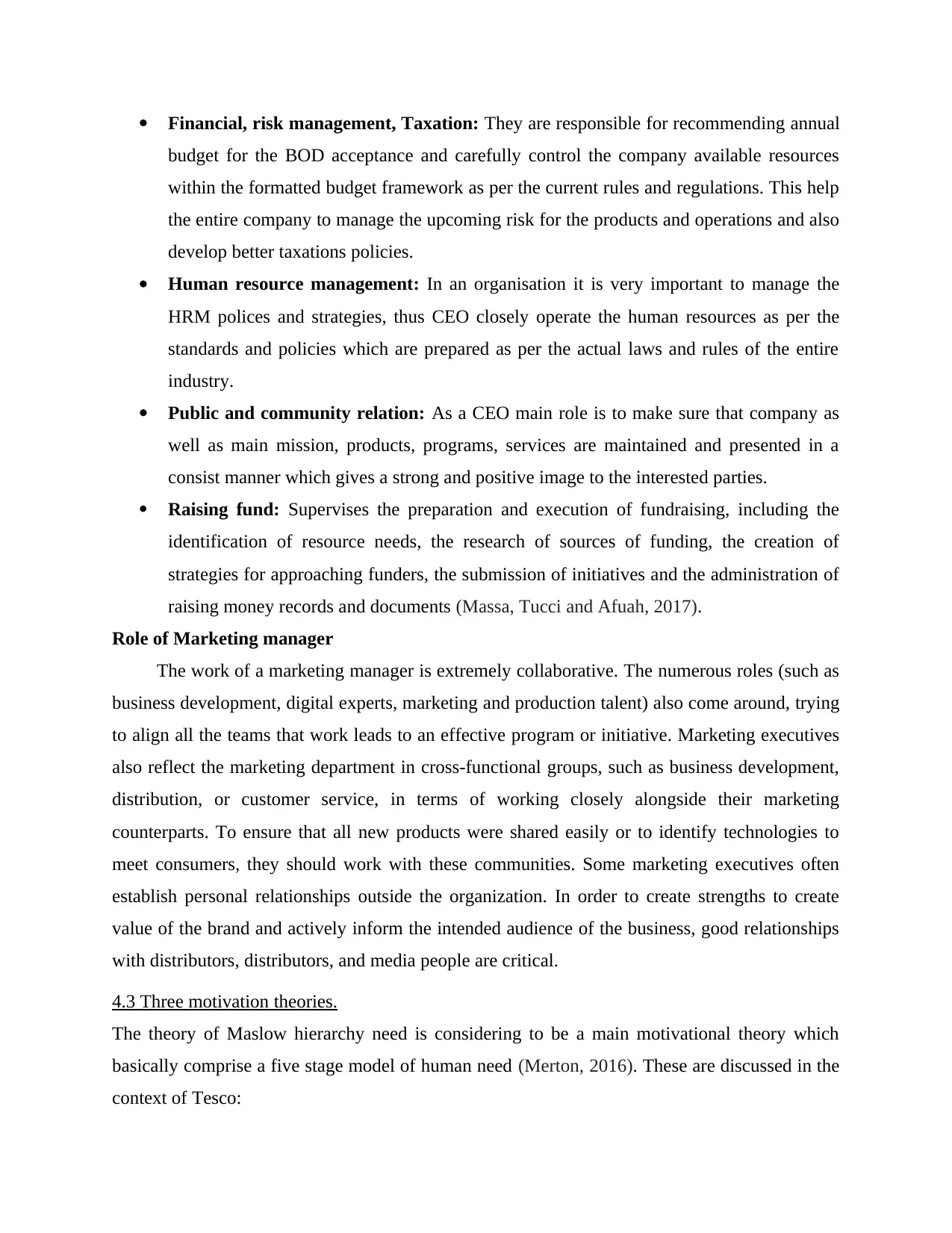
Financial, risk management, Taxation: They are responsible for recommending annual
budget for the BOD acceptance and carefully control the company available resources
within the formatted budget framework as per the current rules and regulations. This help
the entire company to manage the upcoming risk for the products and operations and also
develop better taxations policies.
Human resource management: In an organisation it is very important to manage the
HRM polices and strategies, thus CEO closely operate the human resources as per the
standards and policies which are prepared as per the actual laws and rules of the entire
industry.
Public and community relation: As a CEO main role is to make sure that company as
well as main mission, products, programs, services are maintained and presented in a
consist manner which gives a strong and positive image to the interested parties.
Raising fund: Supervises the preparation and execution of fundraising, including the
identification of resource needs, the research of sources of funding, the creation of
strategies for approaching funders, the submission of initiatives and the administration of
raising money records and documents (Massa, Tucci and Afuah, 2017).
Role of Marketing manager
The work of a marketing manager is extremely collaborative. The numerous roles (such as
business development, digital experts, marketing and production talent) also come around, trying
to align all the teams that work leads to an effective program or initiative. Marketing executives
also reflect the marketing department in cross-functional groups, such as business development,
distribution, or customer service, in terms of working closely alongside their marketing
counterparts. To ensure that all new products were shared easily or to identify technologies to
meet consumers, they should work with these communities. Some marketing executives often
establish personal relationships outside the organization. In order to create strengths to create
value of the brand and actively inform the intended audience of the business, good relationships
with distributors, distributors, and media people are critical.
4.3 Three motivation theories.
The theory of Maslow hierarchy need is considering to be a main motivational theory which
basically comprise a five stage model of human need (Merton, 2016). These are discussed in the
context of Tesco:
budget for the BOD acceptance and carefully control the company available resources
within the formatted budget framework as per the current rules and regulations. This help
the entire company to manage the upcoming risk for the products and operations and also
develop better taxations policies.
Human resource management: In an organisation it is very important to manage the
HRM polices and strategies, thus CEO closely operate the human resources as per the
standards and policies which are prepared as per the actual laws and rules of the entire
industry.
Public and community relation: As a CEO main role is to make sure that company as
well as main mission, products, programs, services are maintained and presented in a
consist manner which gives a strong and positive image to the interested parties.
Raising fund: Supervises the preparation and execution of fundraising, including the
identification of resource needs, the research of sources of funding, the creation of
strategies for approaching funders, the submission of initiatives and the administration of
raising money records and documents (Massa, Tucci and Afuah, 2017).
Role of Marketing manager
The work of a marketing manager is extremely collaborative. The numerous roles (such as
business development, digital experts, marketing and production talent) also come around, trying
to align all the teams that work leads to an effective program or initiative. Marketing executives
also reflect the marketing department in cross-functional groups, such as business development,
distribution, or customer service, in terms of working closely alongside their marketing
counterparts. To ensure that all new products were shared easily or to identify technologies to
meet consumers, they should work with these communities. Some marketing executives often
establish personal relationships outside the organization. In order to create strengths to create
value of the brand and actively inform the intended audience of the business, good relationships
with distributors, distributors, and media people are critical.
4.3 Three motivation theories.
The theory of Maslow hierarchy need is considering to be a main motivational theory which
basically comprise a five stage model of human need (Merton, 2016). These are discussed in the
context of Tesco:
⊘ This is a preview!⊘
Do you want full access?
Subscribe today to unlock all pages.

Trusted by 1+ million students worldwide
1 out of 20
Related Documents
Your All-in-One AI-Powered Toolkit for Academic Success.
+13062052269
info@desklib.com
Available 24*7 on WhatsApp / Email
![[object Object]](/_next/static/media/star-bottom.7253800d.svg)
Unlock your academic potential
Copyright © 2020–2025 A2Z Services. All Rights Reserved. Developed and managed by ZUCOL.





